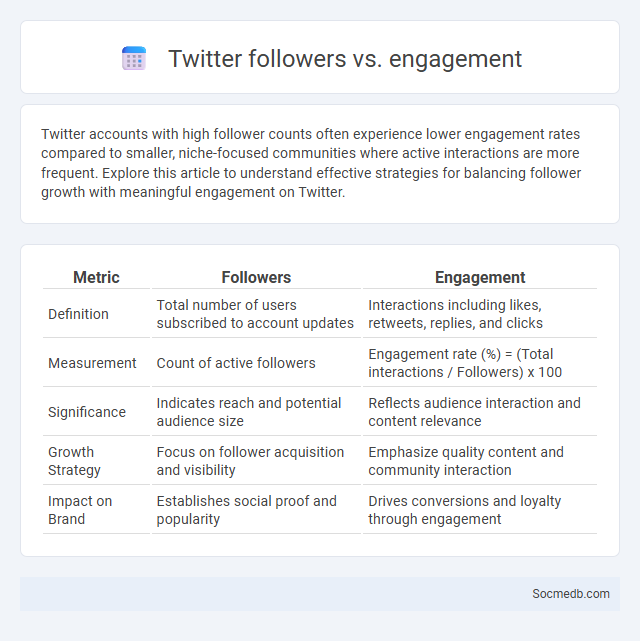
Photo illustration: Twitter followers vs engagement
Twitter accounts with high follower counts often experience lower engagement rates compared to smaller, niche-focused communities where active interactions are more frequent. Explore this article to understand effective strategies for balancing follower growth with meaningful engagement on Twitter.
Table of Comparison
| Metric | Followers | Engagement |
|---|---|---|
| Definition | Total number of users subscribed to account updates | Interactions including likes, retweets, replies, and clicks |
| Measurement | Count of active followers | Engagement rate (%) = (Total interactions / Followers) x 100 |
| Significance | Indicates reach and potential audience size | Reflects audience interaction and content relevance |
| Growth Strategy | Focus on follower acquisition and visibility | Emphasize quality content and community interaction |
| Impact on Brand | Establishes social proof and popularity | Drives conversions and loyalty through engagement |
Introduction to Twitter Followers and Engagement
Understanding Twitter followers and engagement is crucial for growing your social media presence effectively. Followers represent the audience interested in your content, while engagement measures their interaction through likes, retweets, and replies. Maximizing your followers' engagement boosts visibility and strengthens your Twitter influence, helping you connect with your target audience more powerfully.
Understanding Twitter Followers: Numbers vs Value
Understanding Twitter followers involves recognizing that quantity does not always equate to quality or genuine engagement. Your most valuable followers are those who interact with your content, amplify your message, and align with your brand goals rather than just increasing sheer numbers. Prioritizing meaningful connections and active engagement metrics will enhance your social media strategy and deliver more substantial value over time.
What is Twitter Engagement? Key Metrics to Track
Twitter engagement measures how users interact with your tweets, reflecting the effectiveness of your content in capturing attention and prompting action. Key metrics to track include retweets, likes, replies, mentions, and click-through rates, which provide insights into audience interest and content reach. Monitoring these metrics helps you optimize your strategy and increase your Twitter presence.
Followers vs Engagement: The Critical Differences
Followers represent the quantity of people who have chosen to see Your content regularly, but engagement measures how actively these followers interact through likes, comments, shares, or clicks. Engagement rates provide deeper insight into the effectiveness of Your social media strategy by reflecting genuine interest and connection. Brands with high engagement often experience better visibility and stronger community loyalty compared to those focusing solely on follower count.
Why Engagement Can Matter More Than Follower Count
High engagement rates on social media indicate active interaction and genuine interest from followers, which often leads to better brand loyalty and increased conversion rates compared to a large but passive follower base. Algorithms on platforms like Instagram, Facebook, and TikTok prioritize content with higher engagement, boosting visibility and organic reach. Brands leveraging engagement metrics see improved customer insights and more effective marketing ROI than those focusing solely on follower count.
Building a Quality vs Quantity Twitter Audience
Building a quality Twitter audience involves engaging with followers who align with your brand values, actively participating in relevant conversations, and sharing insightful content that encourages interaction. Prioritizing meaningful connections over sheer follower numbers enhances engagement rates and fosters trust, leading to higher conversion and retention. Monitoring metrics like retweets, replies, and click-through rates helps identify authentic engagement and optimize audience growth strategies effectively.
The Myth of High Follower Counts on Twitter
High follower counts on Twitter often create a misleading perception of influence, as many accounts accumulate followers through inactive or fake profiles rather than genuine engagement. True impact on social media depends more on interaction metrics such as retweets, comments, and shares, which reflect authentic audience involvement. Brands and individuals seeking meaningful connections should prioritize quality over quantity in follower growth strategies.
Strategies to Boost Engagement with Existing Followers
To boost engagement with your existing followers on social media, consistently share high-quality, relevant content that resonates with their interests and encourages interaction. Utilize interactive features such as polls, questions, and live videos to foster direct communication and feedback. Analyze engagement metrics regularly to tailor your content strategy, ensuring you meet the needs and preferences of your audience effectively.
Leveraging Analytics: Tracking Follower Growth & Engagement
Leveraging analytics allows you to track follower growth and engagement effectively, providing insights into which content resonates most with your audience. By monitoring metrics such as likes, shares, comments, and follower demographics, you can optimize your social media strategy to boost visibility and interaction. Utilizing tools like Google Analytics and platform-specific insights enables data-driven decisions that enhance your social media presence and drive sustained growth.
Conclusion: Finding the Right Balance on Twitter
Finding the right balance on Twitter requires managing your posting frequency to engage followers without overwhelming them, ensuring content quality aligns with your brand's voice and audience interests. Utilizing analytics tools helps optimize timing and topics for maximum impact while maintaining authentic interactions to build trust. Your effective Twitter strategy boosts visibility, drives engagement, and strengthens your online presence.
 socmedb.com
socmedb.com